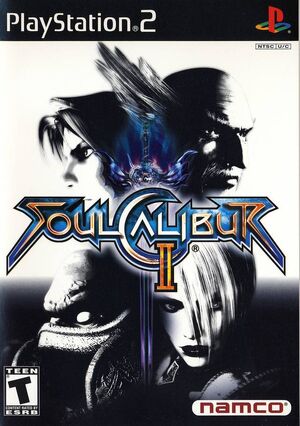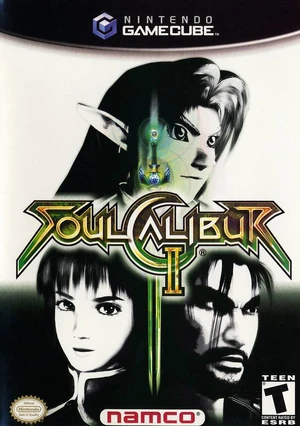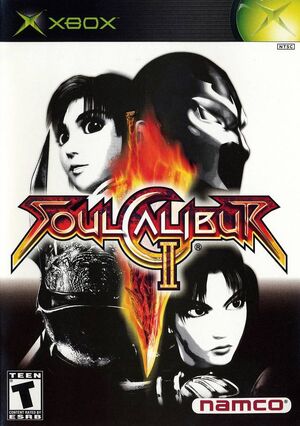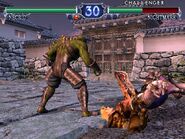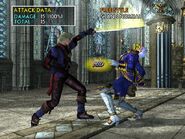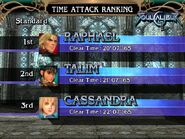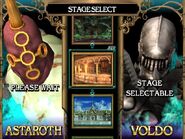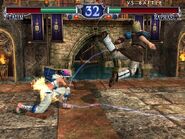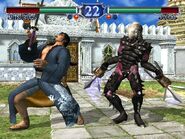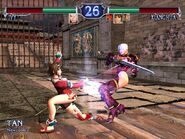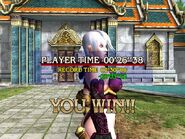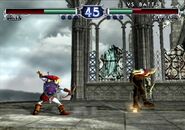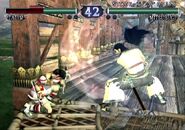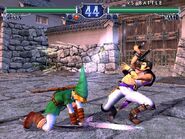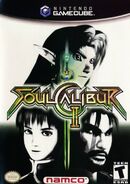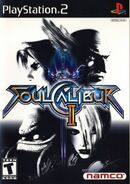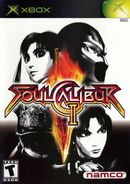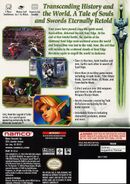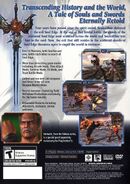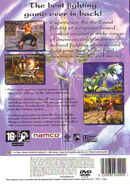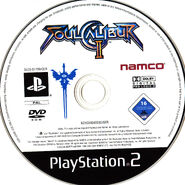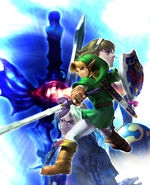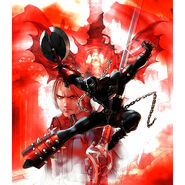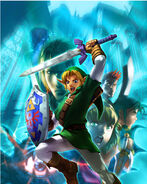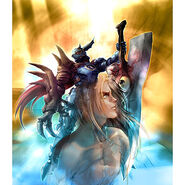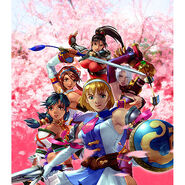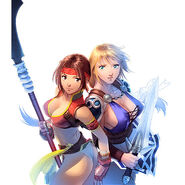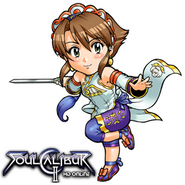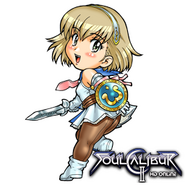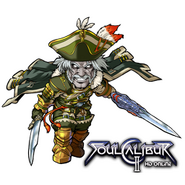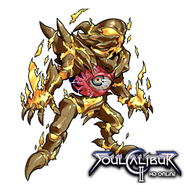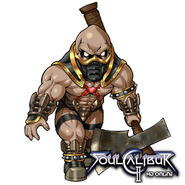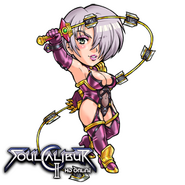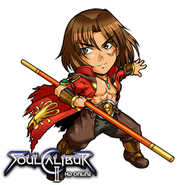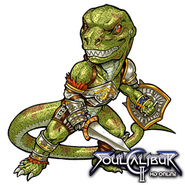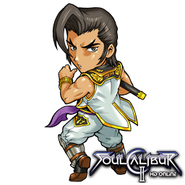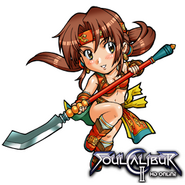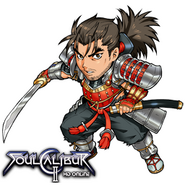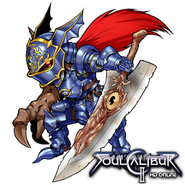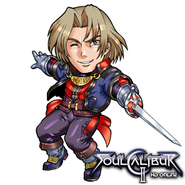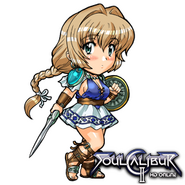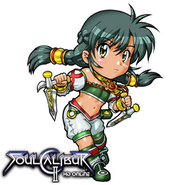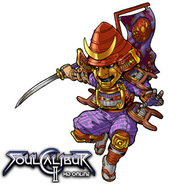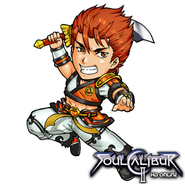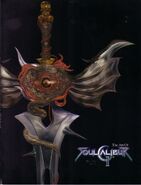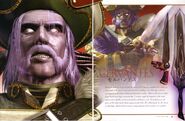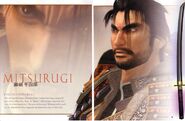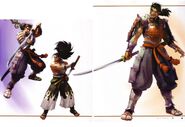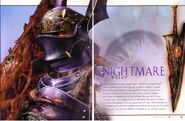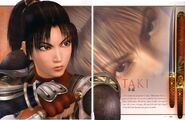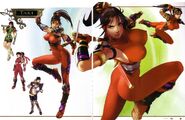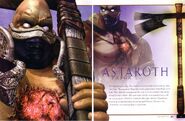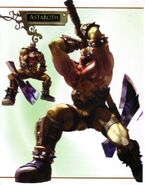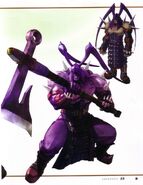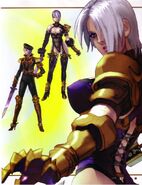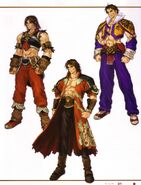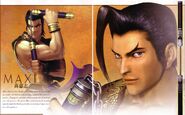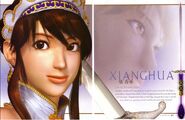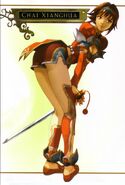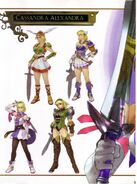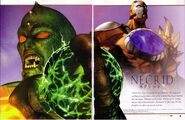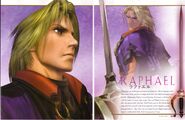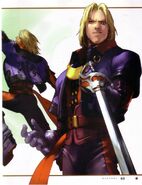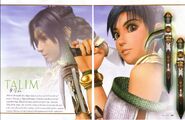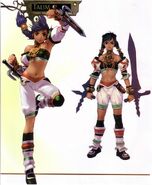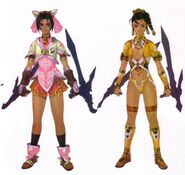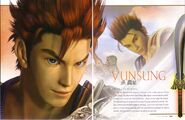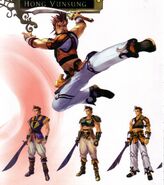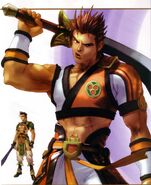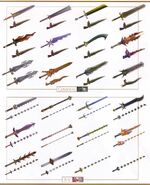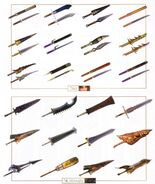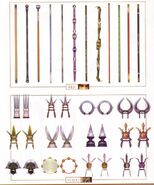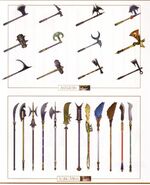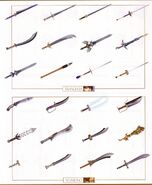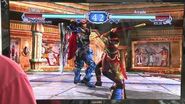
|
This page uses content from Wikipedia. The original article was at Soulcalibur II. The list of authors can be seen in the page history. As with Soulcalibur Wiki, the text of Wikipedia is available under the GNU Free Documentation License. |
| Soulcalibur II | |
|---|---|
| Developer(s) | Namco |
| Publisher(s) | Namco |
| Designer(s) | Hiroaki Yotoriyama Masaki Hoshino (HD Online) |
| Picture format | 1080p (HDTV) (HD Online) 720p (HDTV) (Xbox) 480p (EDTV) 480i (SDTV) |
| Platform(s) | Arcade GameCube PlayStation 2 Xbox PlayStation 3 (HD Online) Xbox 360 (HD Online) |
| Released | Arcade July 30, 2002 Consoles JP March 27, 2003 NA August 27, 2003 EU September 26, 2003 HD Online November 20, 2013 |
| Genre(s) | Fighting |
| Mode(s) | Up to 2 players simultaneously |
| Input methods | 8-way joystick, 6 buttons (arcade) DualShock Controller (PS2) Gamecube Controller (GCN) XBOX Controller (Xbox) |
| Cabinet | Upright |
| Arcade system | Namco System 246 |
| Previous Soulcalibur |
Next Soulcalibur III |
Soulcalibur II (ソウルキャリバーII Souru Kyaribā Tsū?) is a fighting game developed and published by Namco and the third installment in the Soul series. Soul Calibur is the name of the holy sword, created to battle the evil sword Soul Edge, which the games' story line revolves around. Compared to Soulcalibur, Soulcalibur II boasts improved graphics and introduces new characters, stages, and music. It is also the first game in the series to include guest characters from other series.
Gameplay
Modes and features
Modes and other features added to the Home Versions:
- The home versions of Soulcalibur II featured a unique character, Necrid, who did not appear in the arcade version, nor in any subsequent games.
- Soulcalibur II presented the normal modes from most fighting games: Arcade, Team Battle Mode (similar to arcade, but with teams of up to 3 characters and without cutscenes or endings), Time Attack (fight against the clock to gain records), Survival Battle and Training Mode. There are also "Extra" versions of these modes, intended to allow the use of the Extra Weapons. Worth mentioning is that Arcade's 7th battle is called a "Destined Battle", a battle predefined that never changes. Each character has one according to their story, and are shared by groups of two (Mitsurugi→Taki, Taki→Mitsurugi) with the exception of the console-exclusive characters.
- A returning feature from Soulcalibur is the inclusion of Extra Weapons. Instead of Soulcalibur's system of different stats, this one is based on power %, defense %, and special abilities (drains energy, pass through defense, etc.). Each character has 12 different weapons, from the standard (basic) weapons for 1P and 2P to the powerful "Ultimate Weapon". Also each one was granted a Soul Edge version of their arms and a "Joke Weapon", weapons with bad stats and effect, and with unique and funny, hit sounds. Each weapon is given a backstory in the "Weapon Gallery".
- The Arcade version has a unique mode called "Conquest Mode". This mode uses a name and password system to save data and allows the player to choose between one of four armies. The player then chooses one army to fight and gets eight 1-round battles, win or lose (the first seven are based on the player's rank, and the eighth is the player's choice – this can only be interrupted by a Versus challenger.) After each round, the player earns EXP and can be promoted, and the game also rates the player in four categories: Soul, Power, Wisdom and Skill. The game also keeps track of which moves the player knows and uses most often. After the eight battles, territory control is updated and the player has an option to fight a bonus round against their character as played by the AI.
- "Weapon Master Mode" takes the core system from "Conquest Mode" and expands upon it. This mode, made in a similar fashion to Soul Blade's "Edge Master Mode" and Soulcalibur's "Mission Mode", presents a history set in an alternate world, while the player moves in a map divided in "regions" (named after stars) and fight enemies to gain experience points (and raise the "rank" of the character) and money (which could be later used to buy weapons, art, costumes and videos). The mode has 10 normal chapters, 4 sub-chapters and 2 extra-chapters as well as Extra-Missions (alternate version of normal missions). The plot of the mode puts the player into the role of a swordsman searching for Soul Edge, which suddenly is faced against a powerful, mad knight named Veral, who seeks Soul Edge for his own desires.
- As in Soulcalibur, there is a "Museum" containing character artwork, various videos (like Arcade Intro or WMM intro and Ending) and Weapon Exhibition (or "katas"). There is also the "Profile Viewer" (to see character's stories) and "Battle Theater" (to see CPU vs CPU battles).
- Like before, some characters are granted with 3rd costumes, purchased in Weapon Master Mode. Out of the 25 selectable characters, 13 of them were granted a 3rd costume: Astaroth, Cassandra, Ivy, Mitsurugi, Nightmare, Raphael, Seong Mi-na, Sophitia, Taki, Talim, Voldo, and Xianghua. It should also be noted that Link has four costumes (exactly like the ones that he has in Super Smash Bros. for the Nintendo 64), and Assassin, Berserker, and Lizardman each have 6 different costumes (3 color edits of their 2 standard costumes).
- It was the first game in the Soul series to feature the option to hear the characters speak in Japanese or English.
Story
The game is set four years after the end of Soulcalibur, which puts the game's story in the year 1591 AD.
The wave of slaughters that terrorized Europe reached a sudden end. The knight in azure armor, Nightmare, and his followers were successful in collecting enough souls and were about to start the restoration ceremony on the ruins of the once-proud Osthreinsburg Castle. But just as the ceremony was to start, three young warriors assaulted the castle. In a matter of time the cult was defeated and Nightmare stood in front of the young warriors wielding Soul Edge. After an intense battle Nightmare fell, but then the evil soul inside Soul Edge sent the young warriors into a vortex of hellfire and stood to confront them. As a result of Soul Edge's evil aura, Krita-Yuga revealed its true form: that of the Holy Sword, Soul Calibur.
The intense battle ended with the victory of the holy sword, but at the collapse of the vortex of Inferno, both swords along with the Azure Knight Nightmare were sucked in a void and expelled in another place. Siegfried Schtauffen, who was until a moment before the Azure Knight, reclaimed his own mind. Recognizing his sins, he set on a journey of atonement. Still the blade held a strong bond, and every night it took control of the body and took souls of those nearby. The efforts made by the young knight were fruitless, and four years later the Azure Knight returned.
Around those times various warriors came into contact of the blade's remaining fragments, revealing Soul Edge's ultimate survival. After its defeat the fragments began causing chaos and evil to grow in the world. Driven either to possess or destroy the evil sword, each warrior embarks on a new journey, while Nightmare starts his rampage anew, seeking souls to gain the power to restore Soul Edge once again...
Characters
A number of new characters were added in Soulcalibur II along with most of the characters from the previous game. Raphael and Talim's playing styles are entirely unique, while Cassandra and Yun-seong's are derived from established characters Sophitia and Hwang, respectively. Charade, like his predecessors Edge Master and Inferno, switches his style to those of random existing characters with each individual round of fighting. Each of the home versions also included Necrid, who was not included in the arcade version of Soulcalibur II. Necrid, like Spawn, was personally designed by comic book artist Todd McFarlane. Characters in bold must be unlocked.
Returning Characters
- Astaroth - Giant Axe
- Cervantes de Leon - Long Sword and Pistol Sword (can be unlocked by clearing Stage 4 of Chapter 3 in Weapon Master Mode)
- Isabella "Ivy" Valentine - Snake Sword
- Kilik - Bo Staff
- Maxi - Nunchaku
- Heishiro Mitsurugi - Katana
- Nightmare (Siegfried Schtauffen) - Soul Edge/Zweihander
- Seung Mina - Zanbatou (Halberd) (Correctly spelled as "Seong Mi-Na" in subsequent releases, home versions only; can be unlocked by clearing Stage 3 of Chapter 6 in Weapon Master Mode)
- Sophitia Alexandra - Sword and Shield (home versions only; can be unlocked by clearing Stage 5 of Chapter 4 in Weapon Master Mode)
- Taki - Dual Kodachi
- Voldo - Dual Katars
- Chai Xianghua - Jian
- Yoshimitsu - Katana and Sashimono (can be unlocked by clearing Stage 3 of Chapter 2 in Weapon Master Mode)
New Characters
- Cassandra Alexandra – Sword and Shield
- Charade – Imitative Power (can be unlocked by clearing Stage 1 of Chapter 3 in Weapon Master Mode)
- Necrid - Transforming Energy called Enigma (home console exclusive)
- Raphael Sorel - Rapier
- Talim – Dual Elbow blades (Bladed Tonfas)
- Hong Yunsung – Dao (Correctly spelled as "Yun-seong" in subsequent releases)
Guest Characters
- Heihachi Mishima - Gauntlets and Karate-style moves [PlayStation 2 and HD Online versions only]
- Spawn - Spawn's Axe, Agony [Xbox and HD Online versions only]
- Link - Master Sword and Hylian Shield [Nintendo GameCube version only]
Other Characters
The North American, Australian, and European versions of the game also contained three unlockable limited-play characters loosely based on characters from Soulcalibur:
- Assassin (generic thug, with a move list derived from Hwang) - Dao (can be unlocked by clearing Stage 2 of Subchapter 3 in Extra Weapon Master Mode)
- Berserker (generic thug, with a move list derived from Rock) - Double-Edged Axe (can be unlocked by clearing Stage 1 of Subchapter 1 in Extra Weapon Master Mode
- Lizardman (generic lizardman from the army created by the cult order, Fygul Cestemus, in Soulcalibur, with a move list derived from Aeon Calcos, the series' primary Lizardman) - Sword and Shield (can be unlocked by reaching Level 72, clearing Subchapter 2 of Weapon Master Mode, and completing Extra Weapon Master Mode).
Action Replay Characters
- Inferno
- Q.Takagi (has Cassandra's model, Mitsurugi's moves and Kilik's weapon model)
- Wovama (has Cassandra's model, Nightmare's moves and Astaroth's weapon model)
From the Soulcalibur character roster, the ones that did not return for Soulcalibur II as characters themselves were Hwang Seong-gyeong, Nathaniel "Rock" Adams, Lizardman (as the lizardmen in the game are not the main model), Siegfried Schtauffen and Edge Master (when playing in Weapon Master mode, Edge Master's name can be referenced in the character classes while leveling up, such as "Iron Edgemaster", "Bronze Edgemaster", etc.) . Inferno is in the game, only this time, he is not a playable character. While Siegfried is not playable as a separate character, he is playable as his alter-ego, Nightmare and Nightmare's 3rd Costume.
Soulcalibur II HD Online
A high-definition version of the game, titled Soulcalibur II HD Online, was released digitally for PlayStation 3 through PlayStation Network and Xbox 360 through Xbox Live in North America and Europe on November 19 and 20, 2013, respectively, and in Japan on February 20, 2014. It includes all game modes from the original releases, as well as support for online only gameplay over PlayStation Network and Xbox Live, respectively. This version of the game includes both Heihachi and Spawn together for the PS3 and 360 release. Link, however, does not return to the HD remake since it is not going to be included on a Nintendo console at this time, due to his rights belonging to Nintendo.
Reception
Soulcalibur II was rated the 18th best game made on a Nintendo System in Nintendo Powers Top 200 Games list.[1] Media reviews of Soulcalibur II were favorable, as the game earned over 91% for all versions on Gamerankings.com, and commercially the game sold well. It has also earned a 9.2/10 from IGN.
The game also did well in the competitive gaming scene, both in the US and abroad, where it was featured in many tournaments for the years after it came out. The game was particularly noted for its balance, as many different characters placed in top levels in tournaments.
After repeated high level play, however, criticisms arose, most notably in some potentially game-breaking bugs which were found, including the 2G bug (which allowed players to block immediately after being Guard Impacted) and G-Step (which allowed players to sidestep vertical attacks and immediately cancel their sidestep, allowing for instant punishment). Many moves in Soulcalibur II are also safe (meaning that if they are guarded, their user will recover to a neutral state before the opponent can retaliate), and characters such as Astaroth benefit more from the Guard Impact system than others. Also, certain characters such as Xianghua and Ivy had many unfair advantages over most of the cast.
Game Rankings currently scores it 90.6% for the PlayStation 2, 92.9% for the GameCube, and 90.8% for the Xbox.
Awards
- E3 2003 Game Critics Awards: Best Fighting Game
- X-Play - 10th best GameCube game of all time
- Screwattack.com - 8th best GameCube game
Also, Soulcalibur II was often cited as one of the best fighting games of all time. For Gamecube, it received the highest reviews. Its overall score for Xbox, PlayStation 2, and Gamecube was a 9.2 out of a 10.
Ports
Soulcalibur II was ported to the Xbox, the Nintendo GameCube, and the PlayStation 2. It is also notable that each of the three home console versions had a unique character exclusive to that version:
- Heihachi Mishima (from the Tekken game series; appears in the PlayStation 2 and HD Online version) - Gauntlets.
- Link (from The Legend of Zelda series; appears in the GameCube version) - Master Sword and Hylian Shield.
- Spawn (from Todd McFarlane's comic book series of the same name; appears in the Xbox and HD Online version) -A massive axe formed from his cape.
Trivia
- Johan Dürer appears in Weapon Master Mode's opening sequence.
- Algol also appears in Weapon Master Mode's opening sequence and there's a city in Weapon Master Mode named after him too.
- Other characters that didn't make the roster such as Hwang, Li Long, Arthur, Rock, and Edge Master appeared in the opening sequence of Weapon Master Mode as well.
- The game marks as Amy's first appearance as she is seen in the game's opening sequence.
- The game is #29 in IGN's Top 100 PS2 games.
- Sophitia and Seong-Mina weren't first playable in the Arcade version but was later added as unlockable characters in the console versions.
- Cassandra's weapons & costume are the most expensive of all the characters
- Soulcalibur II was the first game in the series to be a sponsor of a wrestling event. That being WWE Unforgiven, back in September 2003.
- HD Online marks the first time that two guest characters (Heihachi Mishima and Spawn) from two different franchises are playable in the same game.
- Japanese voice's were not available in the English version of HD Online due to the death of Heihachi's voice actor, Daisuke Gouri in 2010. The Japanese version of the game retains the same voice however.
- The PlayStation 2 boxart is associated with Soul Calibur (Evil).
- The GameCube boxart is associated with Soul Calibur.
- The Xbox boxart is associated with Soul Edge.
- From Feb. 20th 2014 to May 20th 2014, people who purchase Soulcalibur II HD from the Japan PSN store during this period will receive a 3-piece set to use in Soulcalibur: Lost Swords. (applicable only for Japanese version). This set includes:
- One AP recovery potion
- One continue ticket
- A female-only CAS item, a triangle bikini.
- Soulcalibur II is set in the year 1591, four years after the events of Soulcalibur and seven years after the events of Soul Edge.
- It shares this date with Soulcalibur III and Soulcalibur IV.
- Square Enix’s (formerly Square Soft) Final Fantasy character, Cloud Strife was originally intend to be a guest character in PlayStation 2 version of Soulcalibur II, before being replaced with the second party guest character from Tekken, Heihachi.[2]
Gallery
Screenshots
Box Art
Artwork
Soulcalibur II HD Online
The Art Of SoulCalibur II
Videos
References
- ^ "NP Top 200", Nintendo Power 200: 58–66, February 2006
- ^ https://www.destructoid.com/cloud-strife-was-almost-the-ps2-guest-character-for-soulcalibur-ii-466346.phtml

